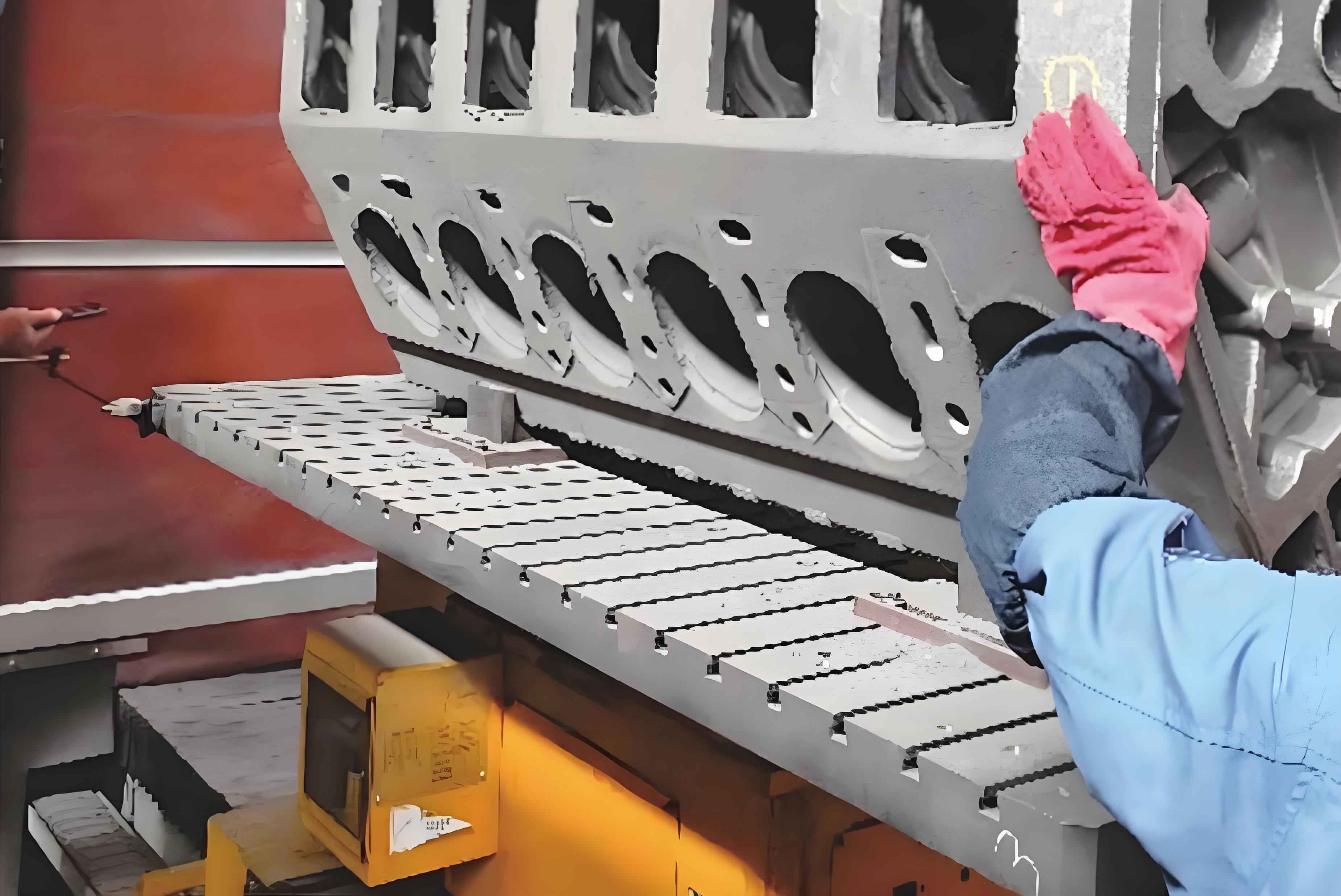
The engine cylinder block, a critical component in modern combustion systems, demands precise thermal management to ensure operational stability. This study focuses on optimizing the casting process for Cummins 2.7 CTI diesel engine cylinder blocks, specifically addressing challenges in water jacket cavity quality caused by thin-walled sand core deformation and sand burning defects.
1. Structural Analysis of Water Jacket Cavity
The 2.7 CTI engine cylinder block features a compact water jacket design with three 3 mm thick inter-cylinder cooling channels spanning 475 mm. The casting parameters include:
- Material: HT250 gray iron
- Weight: 78 kg
- Dimensions: 465 mm × 400 mm × 260 mm
- Production layout: 2 castings/mold
The original triethylamine cold box process using silica sand (AFS 45-52) exhibited core fracture risks and dimensional instability during pouring. Statistical analysis of trial production data revealed:
| Defect Type | Frequency (%) | Critical Locations |
|---|---|---|
| Sand Burning | 62 | Inter-cylinder channels |
| Core Deformation | 38 | Lower cavity surface |
| Residual Coating | 41 | Deep recesses |
2. Mechanism of Sand Burning Defects
Mechanical penetration of molten metal into sand core pores follows the relationship:
$$ d_p = \sqrt{\frac{2\gamma \cos \theta \cdot t}{\mu}} $$
Where:
- $d_p$ = Penetration depth (mm)
- $\gamma$ = Surface tension (N/m)
- $\theta$ = Contact angle (°)
- $t$ = Contact time (s)
- $\mu$ = Metal viscosity (Pa·s)
For silica sand cores (average grain size = 0.3 mm), critical penetration occurs when $d_p > 0.15$ mm. Comparative material properties:
| Property | Silica Sand | Ceramic Foundry Sand |
|---|---|---|
| Thermal Expansion (%) | 1.5 | 0.13 |
| Bulk Density (g/cm³) | 1.45 | 2.05 |
| Refractoriness (°C) | 1,710 | 1,850 |
3. Process Optimization Strategies
3.1 Core Material Innovation
Full replacement of silica sand with ceramic foundry sand (100% Al₂O₃) improved core stability:
$$ \Delta L = \frac{F_{\text{buoyancy}}}{E_{\text{core}} \cdot A_{\text{section}}} $$
Where buoyancy force $F_{\text{buoyancy}} = (\rho_{\text{iron}} – \rho_{\text{core}}) \cdot V_{\text{core}} \cdot g$. Ceramic sand cores reduced deformation $\Delta L$ by 68% compared to silica.
| Parameter | Silica Core | Ceramic Core |
|---|---|---|
| Resin Content (%) | 1.5 | 1.5 |
| Shooting Pressure (bar) | 3.5 | 4.2 |
| Curing Time (s) | 40 | 45 |
3.2 Venting System Redesign
Wire-cut vent inserts (0.2 mm slots @ 2.5 mm pitch) resolved gas entrapment in thin-wall sections. The ventilation efficiency improved by:
$$ Q_v = \frac{n \cdot w^3 \cdot \Delta P}{12\mu L} $$
Where $n$=number of slots, $w$=slot width, $L$=slot length.
3.3 Coating System Upgrade
A dual-layer coating process achieved 0.2-0.3 mm total thickness:
- Zircon-based alcohol coating (50-55°Bé)
- Water-based coating (28-32°Bé)
4. Production Validation
Mass production data (n=5,000 engine cylinder blocks) showed significant improvements:
| Metric | Pre-optimization | Post-optimization |
|---|---|---|
| Sand Burning Rate | 7.2% | 0.8% |
| Dimensional Variance | ±1.5 mm | ±0.4 mm |
| Cleaning Time | 25 min/unit | 8 min/unit |
The enhanced process enables stable production of engine cylinder blocks meeting Cummins’ stringent requirements for water jacket dimensional accuracy (CTQ ≤ 0.5 mm) and surface finish (Ra ≤ 12.5 μm).
5. Conclusion
This systematic approach combining material substitution, process parameter optimization, and equipment redesign successfully resolved thin-wall core challenges in engine cylinder block production. The ceramic foundry sand adoption reduced thermal deformation by 68%, while the venting system redesign improved gas evacuation efficiency by 42%. These advancements provide a technical foundation for manufacturing next-generation high-compactness engine cylinder blocks.
